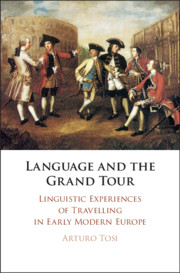Book contents
- Language and the Grand Tour
- Language and the Grand Tour
- Copyright page
- Dedication
- Dedication
- Contents
- Figures
- Preface
- Acknowledgements
- Chronology
- Introduction
- Part I Attitudes and Aptitudes
- Part II Encounters and Exchanges
- 4 Language Acquisition and Learning Abroad
- 5 Aids, Strategies and Facilitators
- 6 Latin and Other Lingua Francas
- Part III Contrasts and Collisions
- References
- Index of Names
- Subject Index
6 - Latin and Other Lingua Francas
from Part II - Encounters and Exchanges
Published online by Cambridge University Press: 23 March 2020
- Language and the Grand Tour
- Language and the Grand Tour
- Copyright page
- Dedication
- Dedication
- Contents
- Figures
- Preface
- Acknowledgements
- Chronology
- Introduction
- Part I Attitudes and Aptitudes
- Part II Encounters and Exchanges
- 4 Language Acquisition and Learning Abroad
- 5 Aids, Strategies and Facilitators
- 6 Latin and Other Lingua Francas
- Part III Contrasts and Collisions
- References
- Index of Names
- Subject Index
Summary
Latin was consistently perceived as superior, a classical language expressing the perfection of the common civilisation that formed the roots of all European nations. By contrast, the modern vernaculars were perceived as having been corrupted by interference from languages spoken by non-European populations. As the Grand Tour evolved in the eighteenth century and modern languages began to prevail over Latin, the use of Latin as a lingua franca, which was resorted to for essential enquiries on the road, gave way to employing the classical language to stress a change in mood. Alongside differences in pronunciation, there were also local neologisms, regional simplifications and variations in pragmatic acts like rules of address, all of which increased the complexity of using Latin as lingua franca. While Latin retreated to being used in written domains, the advantages of using French as a lingua franca gradually surfaced. In diplomatic circles, the hegemony of Latin clung on, as its high level of standardisation was unrivalled by any language used within a specific national community. French came to rival Italian around the middle of the seventeenth century, after more than a century of the most direct descendant of Latin being used as a lingua franca.
Keywords
- Type
- Chapter
- Information
- Language and the Grand TourLinguistic Experiences of Travelling in Early Modern Europe, pp. 168 - 188Publisher: Cambridge University PressPrint publication year: 2020

